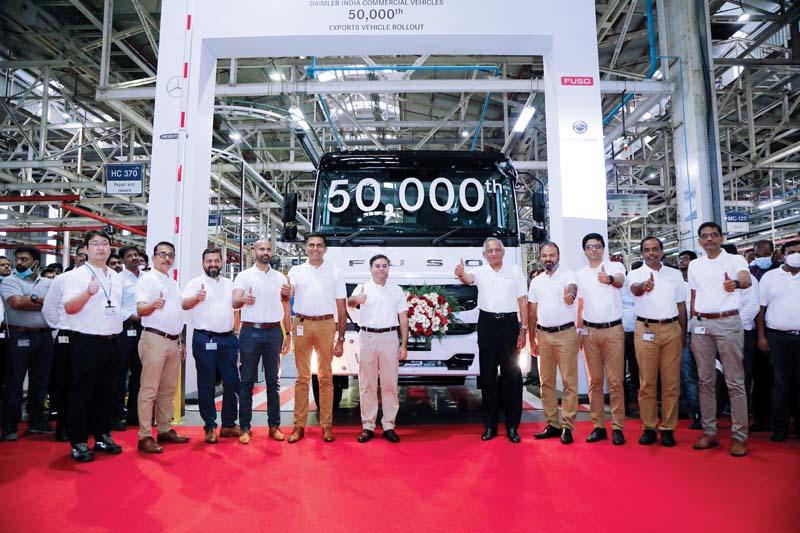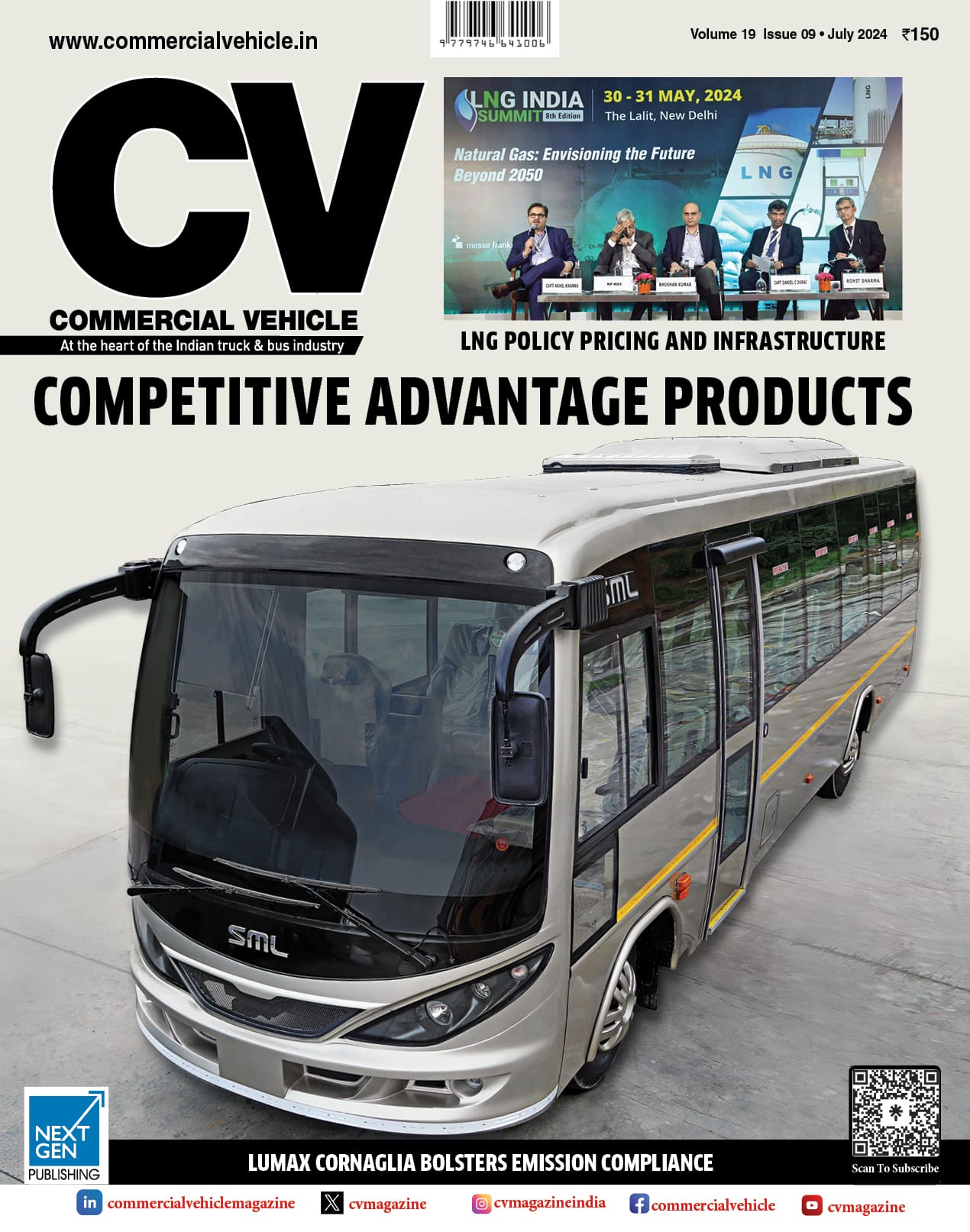Daimler India Commercial Vehicles is celebrating a decade of operations. Ashish Bhatia looks at the learnings gathered en route to solidifying its position.
 Daimler India Commercial Vehicles (DICV) commenced India operations in 2012. Drawing from Daimler Truck AG, Germany DNA, and operating under the umbrella of Daimler Trucks Asia, the aim was to transform the Indian commercial vehicle industry with new benchmarks in engineering, technology, safety and comfort. With this aspiration, it launched the BharatBenz brand of trucks and buses. In the first decade of operations in the Indian market, DICV has sold over 125,000 vehicles, exported over 50,000 vehicles and more than 200 million parts to over 60 countries around the world. BharatBenz trucks and buses are retailed and serviced out of 275 plus sales and service touch points across the country.
Daimler India Commercial Vehicles (DICV) commenced India operations in 2012. Drawing from Daimler Truck AG, Germany DNA, and operating under the umbrella of Daimler Trucks Asia, the aim was to transform the Indian commercial vehicle industry with new benchmarks in engineering, technology, safety and comfort. With this aspiration, it launched the BharatBenz brand of trucks and buses. In the first decade of operations in the Indian market, DICV has sold over 125,000 vehicles, exported over 50,000 vehicles and more than 200 million parts to over 60 countries around the world. BharatBenz trucks and buses are retailed and serviced out of 275 plus sales and service touch points across the country.
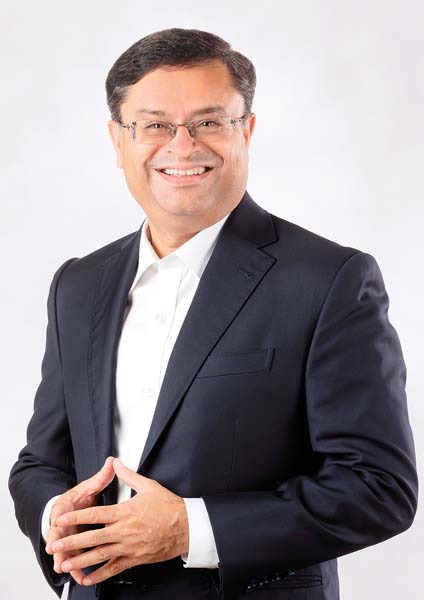
With an investment of over Rs.9,560 crore in a state-of-the-art, green field manufacturing plant in Oragadam near Chennai, the latter being the nerve centre with indigenous R&D and training operations. The R&D operations are known to cater to Indian as well as Daimler Truck Global requirements. DICV produces and sells trucks from 10- to 55-tonne as well as BharatBenz buses, Mercedes-Benz coaches, and bus chassis. Averred Satyakam Arya – Managing Director and Chief Executive Officer, Daimler India Commercial Vehicles, “In the past decade, we have set new benchmarks in the Indian CV industry by introducing fully-built, factory-fitted truck cabins. We were the first CV manufacturer to launch trucks and buses with Bharat Stage VI (BSVI) engines and have set high standards of quality, safety and comfort in the market.” Claimed to strive for one global quality standard, the OEM produces Daimler Trucks’ brands of Fuso, Mercedes-Benz, and Freightliner. These products along with parts are exported to markets in Africa, Asia, Latin America, and the Middle East. The Mitsubishi Fuso Canter, for example, is a popular choice in the Middle East, in United Arab Emirates.
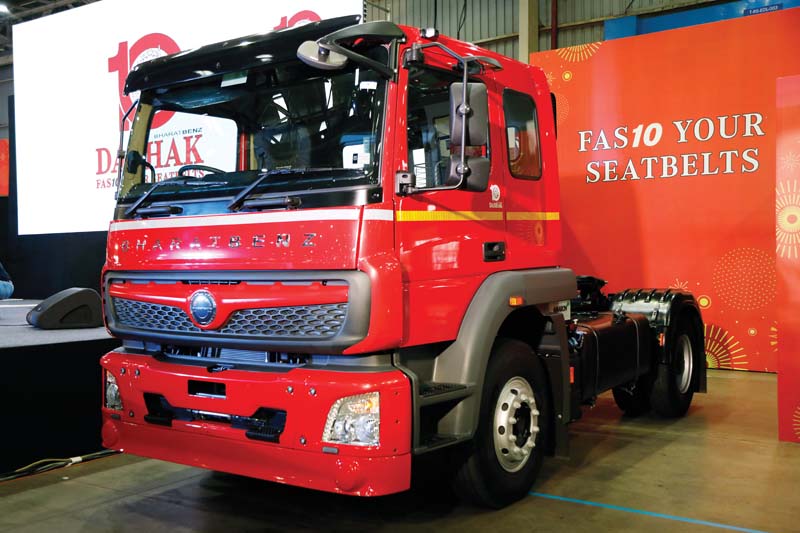 To commemorate the 10th anniversary, DICV also launched the ‘Dashak Edition’ of BharatBenz 1617 Medium Duty Truck (MDT) and 5528 Heavy Duty Truck (HDT) in a fiery red avatar with pearl white chosen for its 36-seater bus. The trucks stand out with the ‘Dashak’ decal commemorating the 10th anniversary. The ‘Dashak Edition’ trucks boast additional features like being fully loaded with air-conditioning, a music system and cameras, and are said to have been introduced for e-commerce and express delivery fleet operators aimed at offering safety and comfort for short hauls. With the BharatBenz 5528 prime mover HDT, the company continues to target long-haul operators having specially tailored the HDT for steel, cement and construction aggregates movement.
To commemorate the 10th anniversary, DICV also launched the ‘Dashak Edition’ of BharatBenz 1617 Medium Duty Truck (MDT) and 5528 Heavy Duty Truck (HDT) in a fiery red avatar with pearl white chosen for its 36-seater bus. The trucks stand out with the ‘Dashak’ decal commemorating the 10th anniversary. The ‘Dashak Edition’ trucks boast additional features like being fully loaded with air-conditioning, a music system and cameras, and are said to have been introduced for e-commerce and express delivery fleet operators aimed at offering safety and comfort for short hauls. With the BharatBenz 5528 prime mover HDT, the company continues to target long-haul operators having specially tailored the HDT for steel, cement and construction aggregates movement.
Preparing for what lies ahead
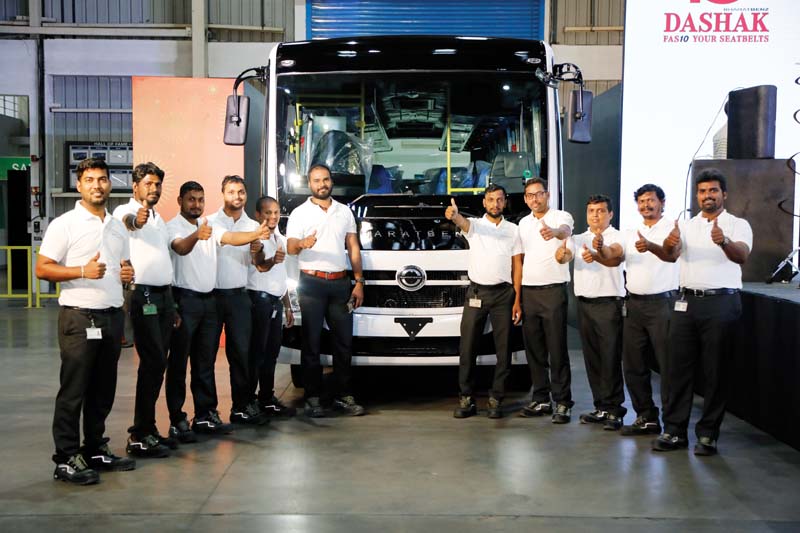 At DICV, the learnings gathered from the first decade of Indian operations are being put to good use. After transitions to BSVI, the company is gearing up for the OBD II, safety regulations expected to influence the industry going forward. Exclaimed Arya, there are lots of learnings and there are no two ways about it! Of the opinion that the company has successfully delivered on its promise of coming out with products that are ahead of the market, the company today boasts of more fuel-efficient products. Arya claimed, that DICV leads on the Total Cost of Operations (TCO), and sets new safety benchmarks, fronts that the company has delivered on.
At DICV, the learnings gathered from the first decade of Indian operations are being put to good use. After transitions to BSVI, the company is gearing up for the OBD II, safety regulations expected to influence the industry going forward. Exclaimed Arya, there are lots of learnings and there are no two ways about it! Of the opinion that the company has successfully delivered on its promise of coming out with products that are ahead of the market, the company today boasts of more fuel-efficient products. Arya claimed, that DICV leads on the Total Cost of Operations (TCO), and sets new safety benchmarks, fronts that the company has delivered on.
In line with the infrastructure development taking place in the country, DICV is closely watching the growing penetration of express highways and multi-modal logistics parks. As per Arya, it is expected to have a bearing over the medium- to long-term. “People will prefer trucks which can do higher speeds which translates to higher horsepower for a better Turn Around Time (TAT), and lower Total Cost of Operations (TCO). It will mean that the entire product portfolio will shift in this direction,” he explained. Opined Arya, with multi-modal logistics parks coming up across the country, there would be a sharper differentiation between light-duty, medium-duty and heavy-duty trucks which presently is not at par with global benchmarks. Attributing the next big ripple effect to the logistics cost in India, estimated to be at 13-14 per cent of the GDP, the company expects it to settle around the eight to 10 per cent mark at par with Germany, for example.
Citing fleet owner affinity to BharatBenz trucks, Arya linked the technology focus at DICV as among the key drivers of transformation in the Indian CV market. The company, going forward will go deeper into its existing markets as it develops products for India and continues to solidify its position with both domestic and export aspirations. Aligning with trends like Mobility-as-a-Service (MaaS) it is preparing itself for what lies ahead. On being asked to pick a drive line of choice, Arya exuded confidence in the strategy of maintaining a portfolio of different fuel options. This includes gas-based options like CNG and LNG instead of being restricted with definitive choices until such time the industry settles down with electric and hydrogen over the long run. He also committed to the push to offer MaaS rather than just a product itself.
Committed to occupant and pedestrian safety, the company wants to continue defining the market movement. Citing a decision taken early on when entering India, Arya pointed at the Original Equipment Manufacturer (OEM) deciding to only have the factory-fitted, well-engineered steel cabins. “I remember, at that time, the entire CV market had only a ~ 20 per cent penetration on the front. 80 per cent of the market constituted the cowl trucks which then go to a body-builder to be fitted with a wooden cabin. I think we both know, how unsafe that product is when it rolls out of the factory. It’s a half-built cabin,” he expressed. Struggling with the fact that India is the only market now offering a BSVI emission-compliant product, at par with global benchmarks or a notch behind, but when it comes to safety, having a lot of ground to cover. “Even now, an estimated 40 per cent of the trucks sold in this market are cowl,” he quipped.
Incorporating sustainability and diversity
DICV, according to Arya, is committed to sustainability in a big way. Drawing attention to having achieved sustainable growth in the domestic as well as export businesses, he said, “we have a plan to accelerate our foray in these two areas, in the coming years. A few key objectives for the next decade are to achieve 100 per cent carbon neutrality in our operations by 2025, become a 100 per cent paper-free organisation by the end of 2023, increase energy self-reliance and have a sharper focus on workplace diversity and culture.” The OEM currently uses 85 per cent of its energy from renewable sources. The company is claimed to have already harnessed solar energy for its manufacturing facility in Oragadam and has laid the foundation for an additional capacity of a 1.3 MW solar photo voltaic plant along the state-of-the-art test track in a 430-acre facility.
The existing solar energy plant has a capacity of 3.3 MW. The OEM is additionally claimed to have already achieved 100 per cent recycling of water and as a result, does not depend on external sources of water for manufacturing. The OEM has now turned the focus toward turning 100 per cent carbon-free by 2025. DICV has a 4000 plus diverse, direct and indirect workforce, working across its plant operations in Oragadam, Global Capability Centre (GCC) in Chennai and regional offices pan India. The creation of over 60,000 jobs in its ecosystem covers dealers, suppliers and other stakeholders wherein it plans to enhance the workforce diversity. This is expected to be given shape through multiple initiatives and in turn positively impact the business and culture within the organisation.
————————————————————————————–
Delivering On Promises
 In an INDUSTRY TALK SESSION, Satyakam Arya, MD & CEO at Daimler India Commercial Vehicles and Chairman of CII, Tamil Nadu State Council speaks to Ashish Bhatia on DELIVERING ON Promises made in a Successful decade of INDIAN operations.
In an INDUSTRY TALK SESSION, Satyakam Arya, MD & CEO at Daimler India Commercial Vehicles and Chairman of CII, Tamil Nadu State Council speaks to Ashish Bhatia on DELIVERING ON Promises made in a Successful decade of INDIAN operations.
Q. Where do you see the demand revival coming from?
A. The market slowed down because of the slowing GDP growth, and that’s now coming back on its feet. This is leading to new demand and the movement of freight, and therefore demand for trucks. The second important aspect is, that in 2019 itself, the market had started to slow down. First due to the transition to BSVI, and then due to Covid-19. So it’s been three years which is a very long period of fleets not being replaced. Now, when GDP is relatively growing healthier, there is an increased demand for the movement of goods. All the fleet owners are coming back and buying new trucks. This is one major dimension which is rolling out in front of us.
The second dimension, which we will see, going forward, and will impact the CV industry is the scrappage policy. The policy has been rolled out but as the infrastructure grows, this includes the scrappage centres and the testing centres, it will have a good impetus on the demand by way of fleet replacement. The third important dimension is regulations. After the transition to Bharat Stage VI, we are gearing up for the OBD II, safety regulations are lined up and these will also influence the industry going forward.
The other standalone dimension is the infrastructure as a whole in itself. We have seen the government investing aggressively in infrastructure. Whether it’s the express highways or the multi-modal logistics parks. These will have an impact in the medium- to long-term. People will prefer trucks which can do higher speeds which translates to higher horsepower for a better Turn Around Time (TAT), and lower Total Cost of Operations (TCO). It will mean that the entire product portfolio will shift in this direction. With multi-modal logistics parks coming up across the country, we will see a sharper differentiation between light-duty, medium-duty and heavy-duty trucks which at present is not at par with global benchmarks.
The next big impact as a ripple effect will be the logistics cost in India, estimated to be at 13-14 per cent of the GDP. This should settle somewhere in the region of eight to 10 per cent which would be at par with Germany, for example. These are some of the factors which are influencing how the industry as a whole is structured.
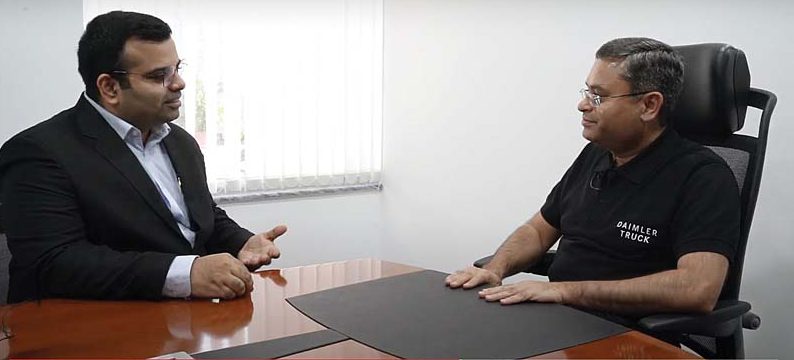 Q. How do you look at the defining trends like turning to a gas-based economy with a shift to CNG for example?
Q. How do you look at the defining trends like turning to a gas-based economy with a shift to CNG for example?
A. There is an uptick in people adopting gas. We all know the reasons behind it. There is an increase in the price of diesel and there is parity with gas. So even if the product may not deliver the same horsepower or torque, people are ready to compromise to bring down their running costs. I believe India is charting its way to transition away from diesel or gasoline. It’s a mix of blended fuels, it’s a mix of gas whether it’s Compressed Natural Gas (CNG) or Liquefied Nitrogen Gas (LNG) and eventually, it will be electric as well as hydrogen. In the mid-term, I see India taking these directions but over the long-term, I see many of these fuel options as transitory options. This means, eventually, in two or three decades, we will settle down with the final solution which could be a mix of electric and hydrogen.
 Q. Tell us about the long-standing focus on driver ergonomics and occupant and pedestrian safety. How have plant safety standards evolved and how are these redefining the ecosystem?
Q. Tell us about the long-standing focus on driver ergonomics and occupant and pedestrian safety. How have plant safety standards evolved and how are these redefining the ecosystem?
A. Safety is deeply ingrained in our value system. Whether it’s our manufacturing plant, our operations or our products we have always been the best on the bench and defined how the market moves. As one example which is a testimony, when we were entering this market just 10 years ago, we decided we will only have factory-fitted, well-engineered steel cabins. I remember, at that time, the entire CV market had only a ~20 per cent penetration on the front. 80 per cent of the market constituted the cowl trucks which then go to a body-builder to be fitted with a wooden cabin. I think we both know, how unsafe that product is when it rolls out of the factory. It’s a half-built cabin.
I struggle with the fact that India is the only market now offering a Bharat Stage VI emission-compliant product, at par with global benchmarks or a notch behind, but when it comes to safety, we have a lot of ground to cover. Even now, an estimated 40 per cent of the trucks sold in this market are cowl. It’s high time that the government should act on it. The entire society and the industry act on it and say we do not deliver what we consider unsafe even if it meets the regulations. We must go above and beyond. I believe, compliance is about doing things right but integrity is about doing the right thing. This has always been our firm belief and going forward we will continue to act on it.
Q. You said it’s just been 10 years since you entered the Indian market. What have been the learnings of the decade gone by and what are the major focus areas for the next decade?
A. There are a lot of learnings and no two ways about it. I believe, we have successfully delivered on our promise on many fronts. We began by promising that we will come out with products that are ahead of the market. They are more fuel-efficient, leaders in TCO, and they will set new safety benchmarks. We have delivered on each of these fronts. To give you an example, whenever I meet my customers, they tell me, that if a fleet owner has a BharatBenz and some other brands, the driver has a natural inclination to drive the former. They don’t want to drive another brand. Even while away on a vacation, they make sure that they get the BharatBenz key back on returning. That’s their way of expressing their love for the product.
With this focus on technology leadership, we’ve also transformed the CV market in a lot of ways. We will continue to strive for this. It is ingrained in BharatBenz and we will never change course. We also supply to 60 markets worldwide. Going forward, the focus will be to go deeper into these markets. So while we develop products for India, we will also continue to explore newer markets and continue to solidify our position as well where exports are concerned. On the future technology front, we are working internally on fronts like Mobility-as-a-Service (MaaS) and preparing ourselves for what lies ahead. To sum up, it will mean different fuel options, and also help our push to offer mobility as a solution rather than just a product itself.
Q. How difficult is it to convince the Indian customer to look beyond acquisition costs to costs over an entire life cycle when selling mobility as a solution?
A. It is the case with a lot of them but not everyone. When we entered the market, we came in with the Total Cost of Operation (TCO) logic. We use to sit across the customer, understand their entire operation and calculate the cost, for instance, over five years. The idea is to explain, that if you buy a BharatBenz, with a slightly higher price than the competition, you will save a lot more in a very short period. This is attributed to better fuel efficiency, better TAT, and also higher safety. We have concluded that customers believe in this ideology. Customers today pro-actively ask for solutions to attain a better TCO. In one exercise, we looked at our entire customer portfolio and found that, on average, someone who buys a BharatBenz, for the first time, buys two trucks. The second time, the same customer buys eight trucks. The third time they buy 22 trucks on average. This tells you that the Indian customers are very cost-savvy but they also understand what gets delivered as a whole over the long term.
Q. You’ve repeatedly quoted the phrase, the more you sweat in peace the less you bleed in war. How does one translate it into business strategy at DICV?
A. I very distinctly remember I was once on my way to the plant here at Oragadam. This was just after the first lock down. We all had apprehensions at that point and time about stepping out of the work from home culture and how it would play out. We did everything possible in our hands to ensure the safety of our people. It was then that I read this Malaysian proverb, I found it to closely correlate with the situation faced. Peace is akin to markets being closed so there was less to sell and hence deemed a peaceful time. I decided we must not let our efforts down and we must continue with our mid-to-long-term strategy and not waver from it. It was the time to do more so that when the crisis is over you find yourselves better prepared. I am happy we could go through with it successfully over the past two years.
Q. How do you see Tamil Nadu growing in stature beyond current levels to draw investment and find favour from the industry as a potential micro-market?
A. I have a very strong belief and confidence on two fronts. As Covid19 subsides, India will emerge with the highest economic growth rate, globally. Within India, Tamil Nadu will be the number one state. We already rank second in terms of GDP after Maharashtra and with all the efforts of the government and the entire industry is putting, Tamil Nadu will be a major attraction for multiple sectors of the economy as far as new investments are concerned. We’ve seen some of these announcements coming in; we’ve seen our honourable Chief Minister leading with participation and industry dialogues to understand their needs, and committing to them, the desired ecosystem to deliver.



